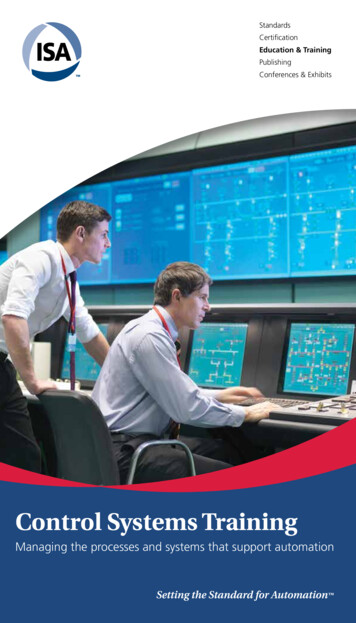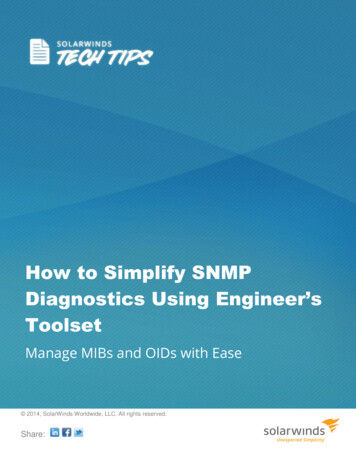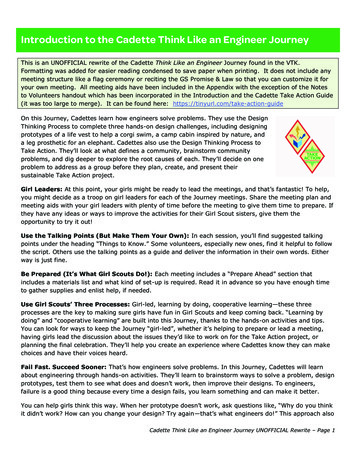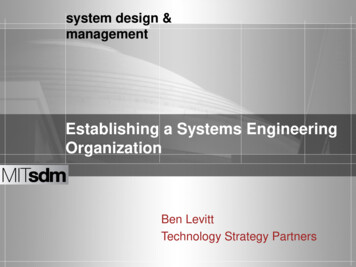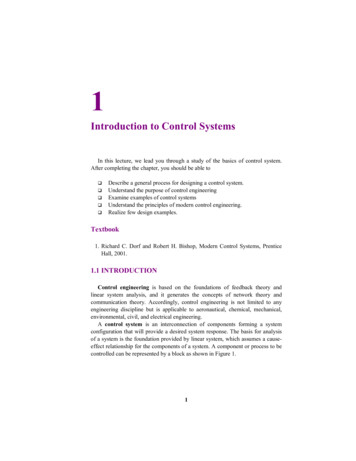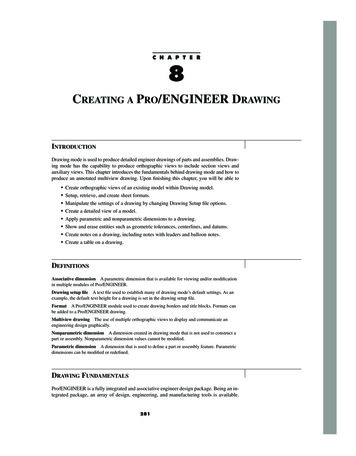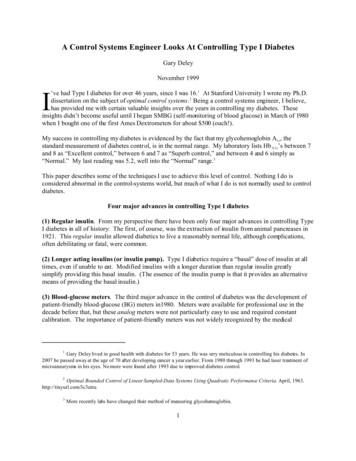
Transcription
A Control Systems Engineer Looks At Controlling Type I DiabetesGary DeleyNovember 1999’ve had Type I diabetes for over 46 years, since I was 16.1 At Stanford University I wrote my Ph.D.dissertation on the subject of optimal control systems.2 Being a control systems engineer, I believe,has provided me with certain valuable insights over the years in controlling my diabetes. Theseinsights didn’t become useful until I began SMBG (self-monitoring of blood glucose) in March of 1980when I bought one of the first Ames Dextrometers for about 500 (ouch!).IMy success in controlling my diabetes is evidenced by the fact that my glycohemoglobin A1c, thestandard measurement of diabetes control, is in the normal range. My laboratory lists Hb A1c’s between 7and 8 as “Excellent control,” between 6 and 7 as “Superb control,” and between 4 and 6 simply as“Normal.” My last reading was 5.2, well into the “Normal” range.3This paper describes some of the techniques I use to achieve this level of control. Nothing I do isconsidered abnormal in the control-systems world, but much of what I do is not normally used to controldiabetes.Four major advances in controlling Type I diabetes(1) Regular insulin. From my perspective there have been only four major advances in controlling TypeI diabetes in all of history: The first, of course, was the extraction of insulin from animal pancreases in1921. This regular insulin allowed diabetics to live a reasonably normal life, although complications,often debilitating or fatal, were common.(2) Longer acting insulins (or insulin pump). Type I diabetics require a “basal” dose of insulin at alltimes, even if unable to eat. Modified insulins with a longer duration than regular insulin greatlysimplify providing this basal insulin. (The essence of the insulin pump is that it provides an alternativemeans of providing the basal insulin.)(3) Blood-glucose meters. The third major advance in the control of diabetes was the development ofpatient-friendly blood-glucose (BG) meters in1980. Meters were available for professional use in thedecade before that, but these analog meters were not particularly easy to use and required constantcalibration. The importance of patient-friendly meters was not widely recognized by the medical1Gary Deley lived in good health with diabetes for 53 years. He was very meticulous in controlling his diabetes. In2007 he passed away at the age of 70 after developing cancer a year earlier. From 1980 through 1993 he had laser treatment ofmicroaneurysms in his eyes. No more were found after 1993 due to improved diabetes control.2Optimal Bounded Control of Linear Sampled-Data Systems Using Quadratic Performance Criteria. April, 1963.http://tinyurl.com/3c3utru3More recently labs have changed their method of measuring glycohemoglobin.1
community at the time, and they were slow to catch on in clinical practice. In 1980 I had to changephysicians to find one that was interested in experimenting with the new meters.When I began testing my blood glucose in March of 1980 I almost immediately was able to bring myglycohemoglobin A1c down from some astronomical value above 10 to around 7. Since then I have takenabout 50,000 BG tests. There was considerable experimentation in the early days of SMBG; it was afruitful field for researchers who liked to write articles for journals such as the newly created AmericanDiabetes Association journal Diabetes Care. In 1981 the first “how to” book came out on controllingdiabetes using SBMG: The GlucograF Method for Normalizing Blood Sugar by Richard K. Bernstein.4(Interestingly enough, Dr. Bernstein was a diabetic patient, not a physician, at the time. He laterobtained a medical degree.) Dr. Bernstein, a Type I diabetic, had access to one of the earliest meters, andhad been experimenting with it during the decade before publishing his book. This proved to be anespecially useful book and I learned many useful concepts from it.During the years between 1980 and 1996 I controlled my diabetes with a combination of regular andultralente insulins along with seven blood-glucose tests a day. These included 3 before meals, 3 betweenmeals, and one before bed. (Later I added an eighth test at 3 a.m.) Despite all this effort, I hadconsiderable fluctuations in my blood sugar. Results from the regular insulin often turned out to beunpredictable, and despite all the effort I still had some blood sugars that were way too high (above 200mg/dl) and too many that were too low (hypoglycemia). I was always astounded that I could begin twosuccessive days with almost exactly the same BG (say 100 mg/dl), take the same amount of insulin, waitthe same amount of time before eating breakfast, eat exactly the same breakfast (including weighing thecarbohydrate) and two hours later have wildly different blood sugars: over 200 mg/dl one day andhypoglycemia the next.I attribute this instability to certain bad properties of regular insulin. If one were to design from scratch ashort-acting insulin for Type I diabetics, regular insulin wouldn’t be it. It has a peak action that is farlonger than it should be to “match” the intake of a meal, regardless of the timing of its injection. Thus alittle too much insulin must be taken to keep the post-meal peak within bounds. An even worse problemof regular insulin is its long tail of action—up to eight hours. It is this tail that causes many of thehypoglycemic episodes. Regular insulin sneaks up on you just when you think you’re out of the woods.I can’t imagine why anyone would use regular insulin if there were a better alternative.(4) Lispro insulin. Which brings me to the fourth important discovery in the control of Type I diabetesmellitus, a better “regular” insulin. This insulin is called lispro and has been marketed in the U.S. by EliLilly and Co. under the brand name Humalog since August, 1996. It is the introduction of lispro that hasallowed me to finally stabilize the control of my diabetes, make the control predictable, and bring myglycohemoglobin A1c down to the normal range. What are the good qualities of lispro? It is about twiceas fast as regular insulin across the board, as shown in a graph included in the Humalog box (seeAppendix). This means that its peak action is about twice as fast as regular, the duration of its principalaction is half as long, and equally important, its “tail” is half as long, about four hours. This lack of a tailhas greatly reduced my episodes of hypoglycemia.4Richard K. Bernstein, The GlucograF Method for Normalizing Blood Sugar, Crown Publish ers, Inc., New York,1981. His most recent book is: Richard K. Bernstein, Dr. Bernstein’s Diabetes Solution: a complete guide to achieving normalblood sugars, Little,, Brown & Company, New York, 1997.2
I’ve been surprised that lispro hasn’t totally replaced regular insulin in all Type I diabetics. I think it willhappen eventually, just as the meters eventually replaced all urine testing. I suppose the primary reasonfor not switching is that the tests of lispro by Lilly did not show any improvement in glycohemoglobinA1c or much lessening of hypoglycemic episodes. Apparently the testers didn’t know what to do with thestuff. Another reason for not switching to lispro may be that its speed of action has been oversold.People seem to have the idea that lispro is dangerously fast, which is patently false. My experience isthat it isn’t all that fast. Even if my BG is normal before a meal, I have never had a problem waiting aslong as a half hour for a meal, although normally I aim for about 5 to 15 minutes. And if my BG is high,say above 180, waiting an hour isn’t too long. This shouldn’t be surprising. I found that regular insulintakes a couple of hours to cause a noticeable drop in high BG. Lispro is about twice as fast, so I find ittakes about an hour to cause a noticeable drop in high BG.Control systemsSo, how do I use the above ingredients to tightly control my Type I diabetes? First, let me introduce alittle nomenclature. We engineers call what is being controlled the controlled variable. The variablebeing controlled in diabetes is, of course, blood glucose, or BG for short. I don’t think of blood glucosefrom a medical viewpoint. To me, it is simply another variable to be controlled using the concepts ofcontrol system theory. This provides a certain objectivity to the process.Before the meters became available, “control” of diabetes was totally open loop. That simply means thatcontrol (such as it was) wasn’t based on actual measurements of the variable being controlled (which wecall feedback), but was based on hope, the hope that doing the same thing every day would produce thesame result, and that result would be acceptable. It clearly wasn’t acceptable, since very high and verylow BGs were the norm in those days, leading to a high glycohemoglobin and diabetic complications.When the meters became available, for the first time diabetics could close the loop, meaning that thediabetic can take actions to control the diabetes based on the actual value of the BG at the moment; if it istoo high, insulin can be taken, and if it is too low, sugar can be ingested. Eating a meal, however, is stillan open-loop process: insulin is injected, the meal is eaten, and it is hoped the result will be OK. (In atotally closed-loop system insulin would be added to the bloodstream only after the BG had begun to risefrom a meal. This would be detected by the control system and immediately insulin would be addeddirectly to the blood stream to lower the BG.)How I control my Type I diabetesDiet. My diet consists of a small amount (15 g) of carbohydrate at each meal (plus whatever additional Ineed for control purposes as discussed below under the heading Sugar. Dr. Bernstein put me on to thisin his first book. His latest book recommends only slow-acting carbohydrates, but I think this is nowunnecessary thanks to lispro insulin. I prefer faster acting carbohydrates such as bread.Basal insulin. It has long been established that Type I diabetics need a certain amount of insulin at alltimes, regardless of meals. This can be provided by a long-acting insulin. The ideal long-acting insulinwould last more than a day and have a flat response; then only one injection a day would be required.Since there is no such thing as an insulin with a flat response, we have to create the flat responseourselves. This can be done by overlapping injections of long-acting insulin. If you’re so inclined, youcan demonstrate for yourself, as I did in 1981, that a fairly flat response can be obtained by overlapping3
three injections of insulin regardless of the response curve of the insulin. Thus, if the duration of aninsulin were 36 hours (as was originally believed to be the duration of animal ultralente), then aninjection every 12 hours would provide the required overlap. (Later, it was discovered, that in smalldoses of the kind taken for basal injection, the actual duration of animal ultralente is closer to 18 hours;taking an injection every 12 hours worked only because of the relatively flat response of animalultralente.)Unfortunately, animal ultralente is no longer marketed; it has been replaced by human ultralente, whichhas a slightly shorter duration and an unpredictable peak. Many diabetics complained that when theywere forced to switch to human ultralente, their control became much more unpredictable. I wascertainly among those complainers; the unpredictable results I got from using a combination of regularinsulin and ultralente became even more unpredictable when I switched to human ultralente as my basalinsulin.I totally solved the problem of human ultralente by going back to my 1981 discovery that any insulin canbe used as a basal insulin as long as three injections overlap. Assuming (charitably) that the duration ofhuman ultralente is about 18 hours, this means that to get a smooth response I need to take an injectionevery six hours. I have been doing this since 1996 and the results have been spectacular. An injection ofhuman ultralente every six hours completely solves the problems of the un-flat response of humanultralente. The response is usually so flat during the night that frequently the three BG tests I take (1)when going to bed, (2) at 3 a.m., and (3) in the morning are all nearly the same.It does not even add to my inconvenience to divide my ultralente into four injections a day. I have foundthat the four shots need not be taken at exactly six hour intervals—wide latitude is OK when taking theinjections. I take three of them with the three meal injections of lispro, and the fourth before going tobed when I take my late evening test.Schedule. The table on the next page shows my daily schedule for controlling my diabetes. Myschedule using lispro is much more flexible than the table implies. The time between the first morningtest and taking lispro insulin can be about anything I want it to be, a great convenience. I no longer haveto wait an hour before breakfast. The only requirement is that there not be much more than 15 minutesbetween taking the lispro and the meal. However, as discussed above, if the test shows a high BG, then Itake extra lispro and wait longer, anywhere from a half hour to an hour depending on the test. Timing isstill important with lispro, and the admonition to take it less than 15 minutes before a meal only applies ifthe BG is normal when taking it.Extra lispro. After any BG test, if my BG is considerably higher than it should be at the time of thattest, I take extra lispro. This is obvious if the BG is too high just before a meal, but I also take extralispro between meals if the value is too high. I find that for me (175 pounds), one unit of lisproconsistently reduces my BG about 30 mg/dl.Sugar. Tight control of diabetes requires lots of sugar. This may sound like heresy to those taught thatsugar is a no-no for diabetics. It makes perfect sense from a control systems point of view. By lots ofsugar I don’t mean indiscriminate intake of carbohydrate; I mean carefully controlled amounts of sugar toraise the BG a precise and known amount. A control system must be able to nudge the controlledvariable in either direction to maintain stability. If BG (the controlled variable) is higher than it shouldbe at the time of a test, then extra lispro is indicated. If it is too low then sugar is indicated. Note thattoo high and too low are relative terms. If a test is taken before a meal, then a good value for BG are in4
TABLE: BG test times and insulin regimeTime (approx)BG testlisproultralente7 a.m.o2u4u7:45 a.m.o2u8 a.m.Breakfast10 a.m.o12 noonoLunch4u15 minutes after injection2 p.m.o5:30 p.m.oDinner6u4u4u15 minutes after injection8 p.m.obedtimeo3-4 a.m.o4uthe range 80 to 110. However, if a test is taken between meals, then a good value might be in the range110 to 140. If a BG is only 80 between meals, and experience has shown that it can drop another 20 or30, then sugar should be taken to raise it into the good range for between meals. If a BG is 170 betweenmeals (a rare event), then enough lispro should be taken to get the BG into the good range by mealtime.How much sugar is needed to raise BG a precise amount? This requires a bit of testing on the part of theuser, as first brought to my attention by Dr. Bernstein’s 1981 book on pages 189ff. He states that oneDextrosol (now called Dextro Energy) will raise the BG of a patient weighing 120 to 150 pounds about15 mg/dl. (There are now several other similar glucose products on the market.) One Dextro Energyweighs 3.3 grams and contains 3 gm carbohydrate, essentially all glucose. Glucose (dextrose) should beused to raise BG fast, since it quickly raises BG by being directly absorbed into the bloodstream. Sinceany dextrose product I have ever tried is not exactly delicious (in fact most of them are barely palatable),I also use candy made from sucrose (table sugar) when speed isn’t a factor (i.e., when my BG is lowerthan it should be to make it to the next meal, but not near the hypoglycemic range). As Bernstein pointsout, sucrose is half glucose and half fructose, so half of the sucrose gets into the bloodstream fast andhalf comes along later; this is the reason I don’t use sucrose to bring up low BGs. I have found that mostfruit is difficult to calibrate; while the quantity of the fruit can be weighed, the sugar concentration variesconsiderably, so I don’t use fruit to bring BG up a prescribed amount.5
Dawn phenomenon.5 For over 15 years I have been in the habit of waiting an hour between taking mymorning regular insulin and eating breakfast. I found it takes at least this long for the regular insulin tobegin working. I began to enjoy the schedule of taking my test and regular insulin right after waking up,then spending the next hour reading the paper and having my first morning cup of coffee. When Iswitched to lispro I wanted to keep the same schedule, but couldn’t wait an hour after taking the lispro.So I took a morning test to make sure I wasn’t too low, waited an hour, and took another test and mymorning insulin. I had been reading about the dawn phenomenon for about as long as I can remember,but this was the first time I experienced its power first hand. I discovered that during that hour, my BGwould sometimes rise as much as 50 or 60 mg/dl, an amount that astounded me.My solution to this problem was to split my lispro between the two tests an hour apart. Assuming my BGis in the normal range when I get up, I take 2 units of lispro (and my ultralente). Then after reading thepaper and having a cup of coffee I take another test, and if my BG has not gone up significantly, I takethe other 2 units of lispro and eat breakfast. Some people might think it is dangerous to take lispro andthen wait an hour to eat, but I have discovered that with this regime the second test is almost never belowthe first test, and if it is it by an insignificant amount. The second test is usually only a slight bit higherthan the first, but if it is significantly higher, I increase the second dose of lispro a unit or so.This regime gives me considerable flexibility in adjusting my morning dose of lispro. If my first test ofthe morning is high, say 120 to 150, then I take an additional unit or two of lispro at that time. If the firsttest of the morning is very high, over 150, then I take all the lispro at that time, upping it as necessary. Ithen wait an hour before breakfast, giving the lispro a chance to begin bringing down my BG to areasonable value.5In the morning the liver starts producing glucose until you eat something. This can cause a diabetic's blood glucoselevel to rise even thou gh they haven't eaten anythi ng yet. A doctor once reco unted an inciden t where a diabetic patie nt who hadn'teaten anything all day came to his office in the afternoon with a blood glucose level of over 300. This is why it's important for adiabetic to eat breakfast, even if their blood glucose level is high. Eating switches off the liver so it stops producing glucose.6
AppendixFigure 2 of the Clinical Pharmacology section of an insert that comes with every bottle of Humaloglispro insulin shows “Serum Humalog and insulin levels after subcutaneous injection of human regularinsulin or Humalog (0.2 U/kg) immediately before a high carbohydrate mea lin 10 patients with Type Idiabetes.”Comparing the two curves of serum free insulin versus time shows that lispro insulin is twice as fast asregular insulin across the board, as shown in the graph below. In this graph the time axis of the regularinsulin has been compressed by a factor of two.To make the comparison easier the vertical axis of each the two curves has been altered as follows: (1)The baseline of 0.5 has been deleted from the original curves under the assumption that the base iscaused by the baseline infusion of 0.2 mU/min/kg. (2) The amplitude of the lispro insulin has also beenreduced by a factor of 1.4 to bring the curves into vertical alignment.66It is interesting to speculate on why this factor is 1.47
4 Richard K. Bernstein, The GlucograF Method for Normalizing Blood Sugar, Crown Publishers, Inc.,New York, 1981. His most recent book is: Richard K. Bernstein, Dr. Bernstein’s Diabetes Solution: a complete guide to achieving normal blood sugars, Little,, Brown & Company, New York, 1997. 2 community at the t

